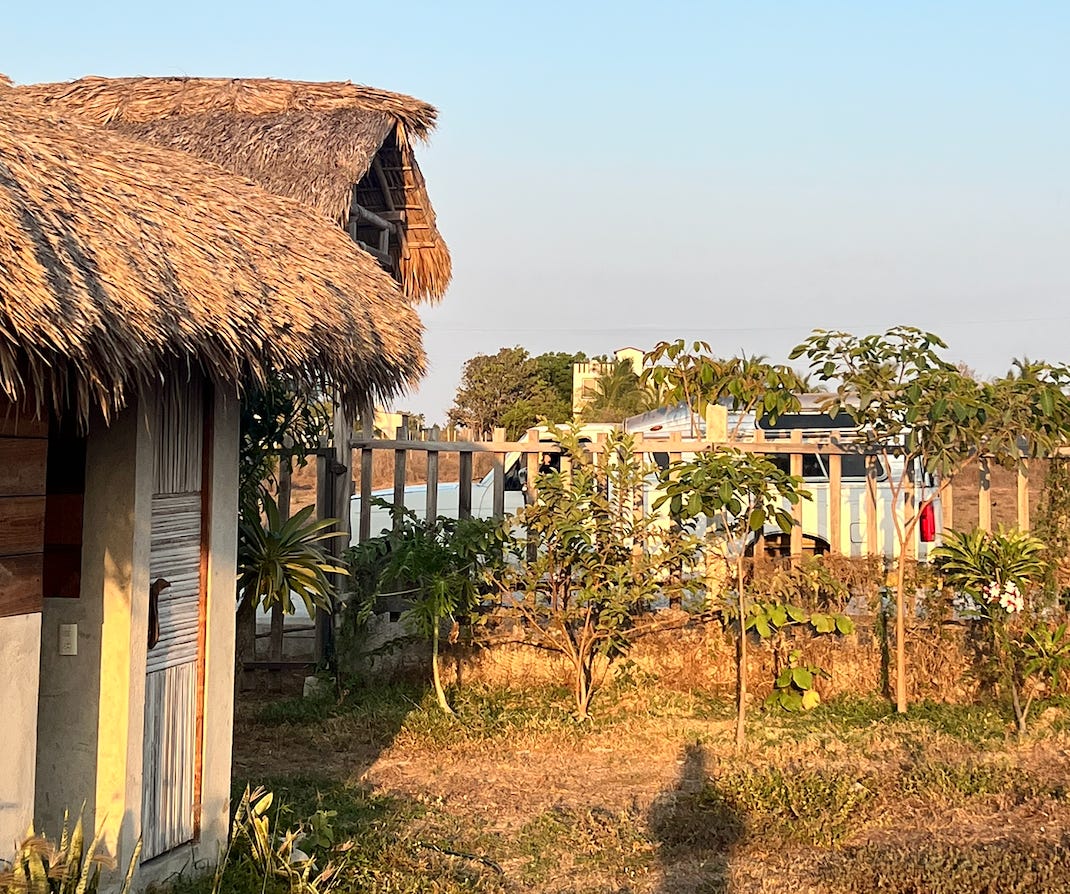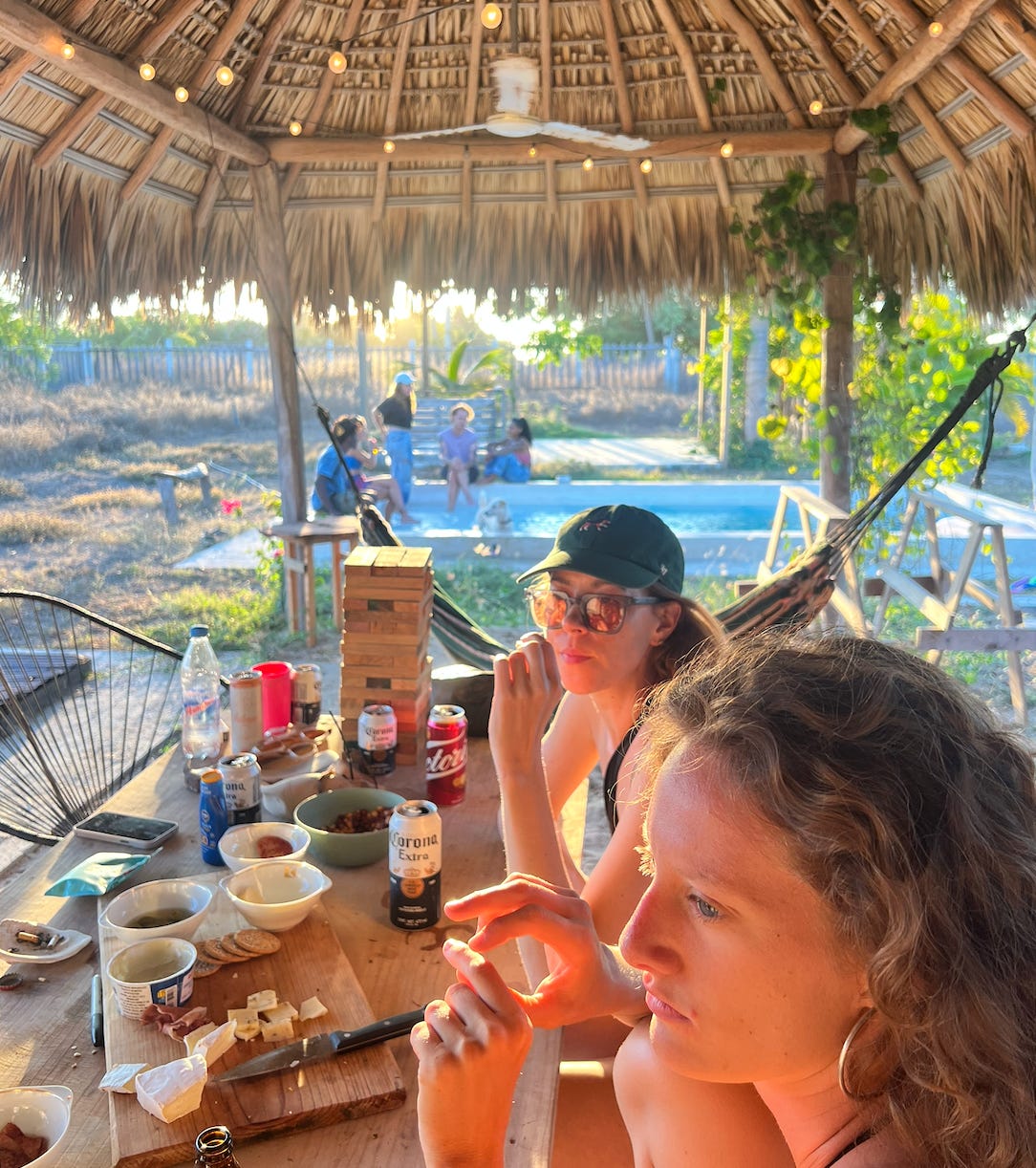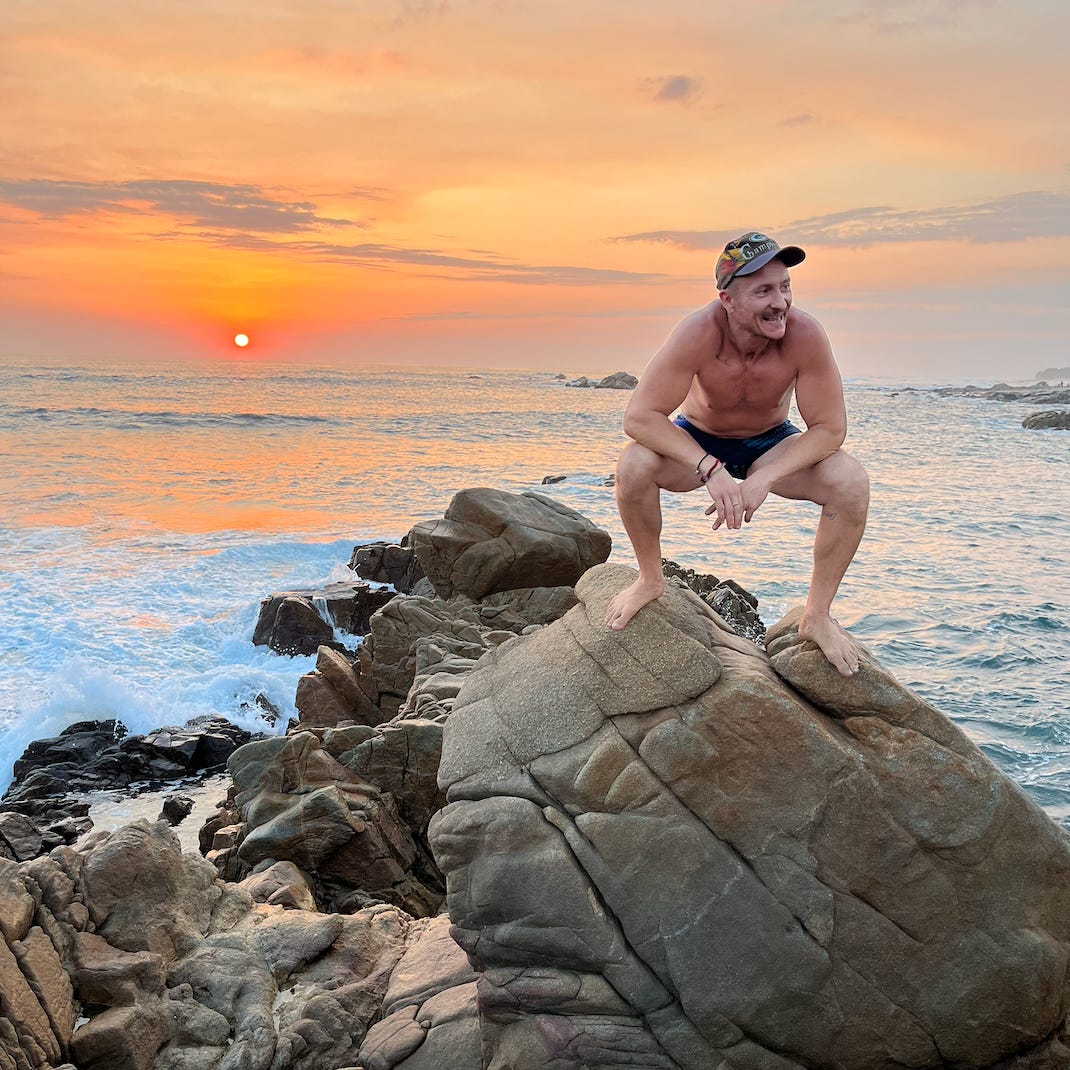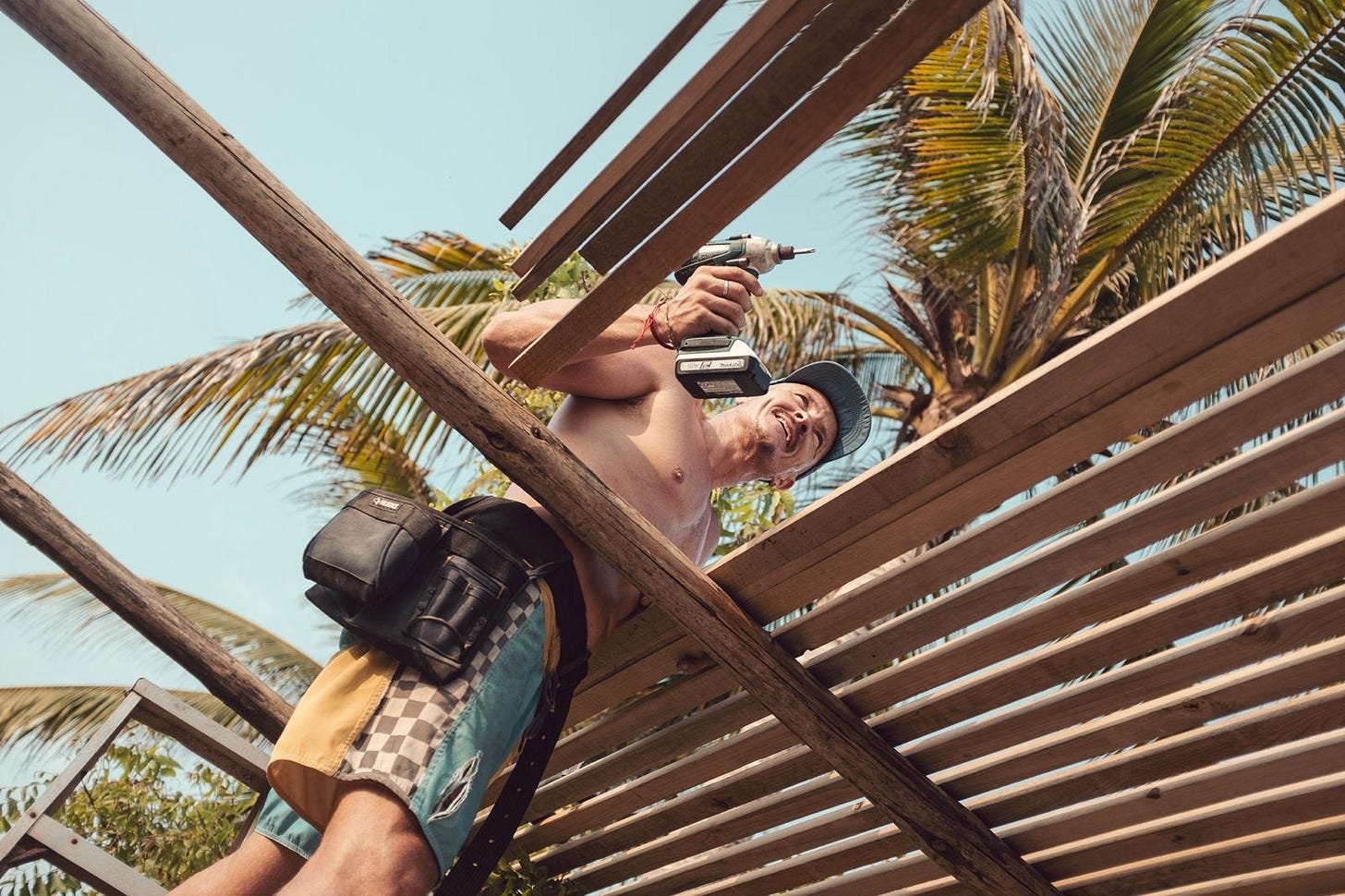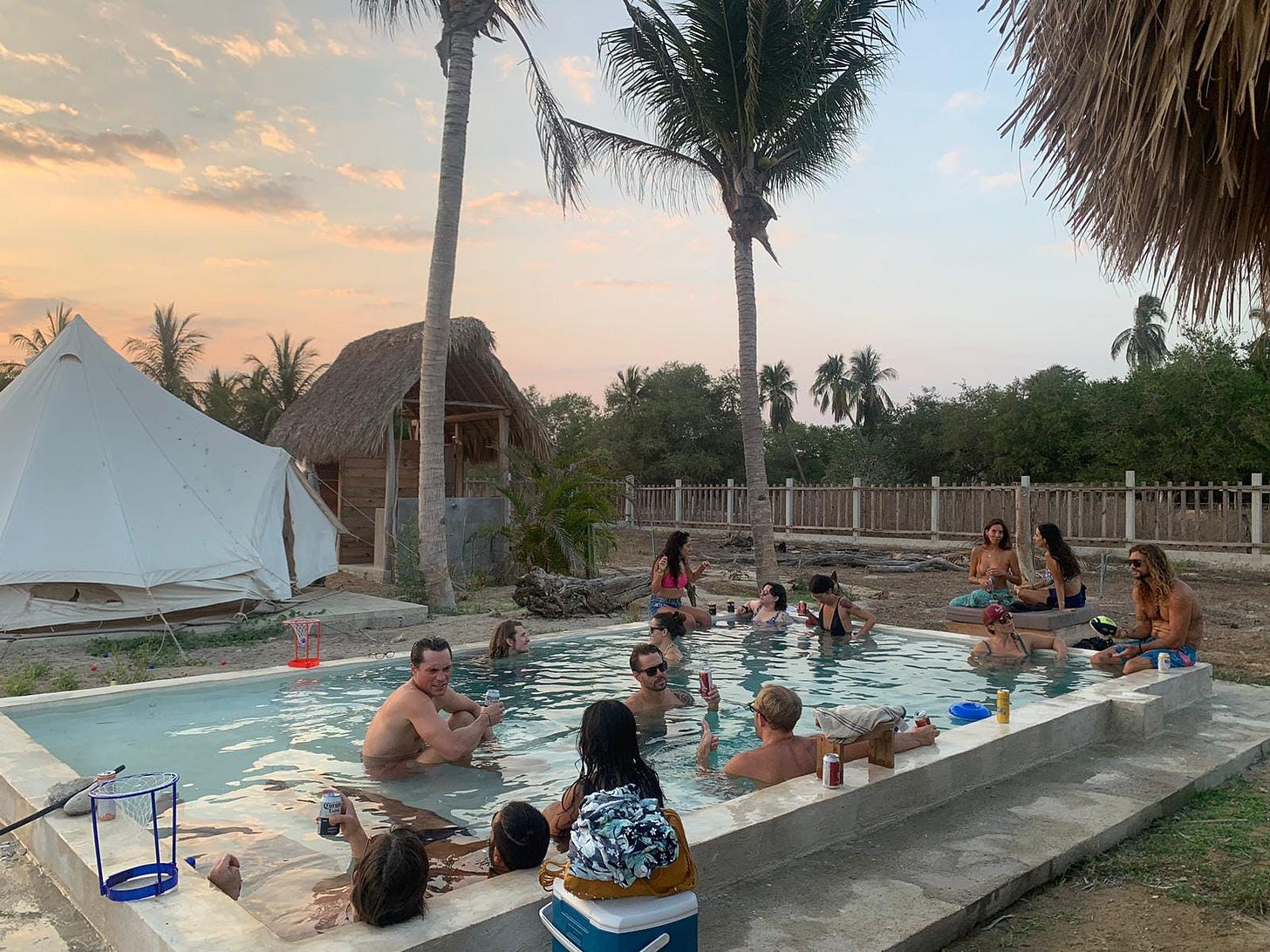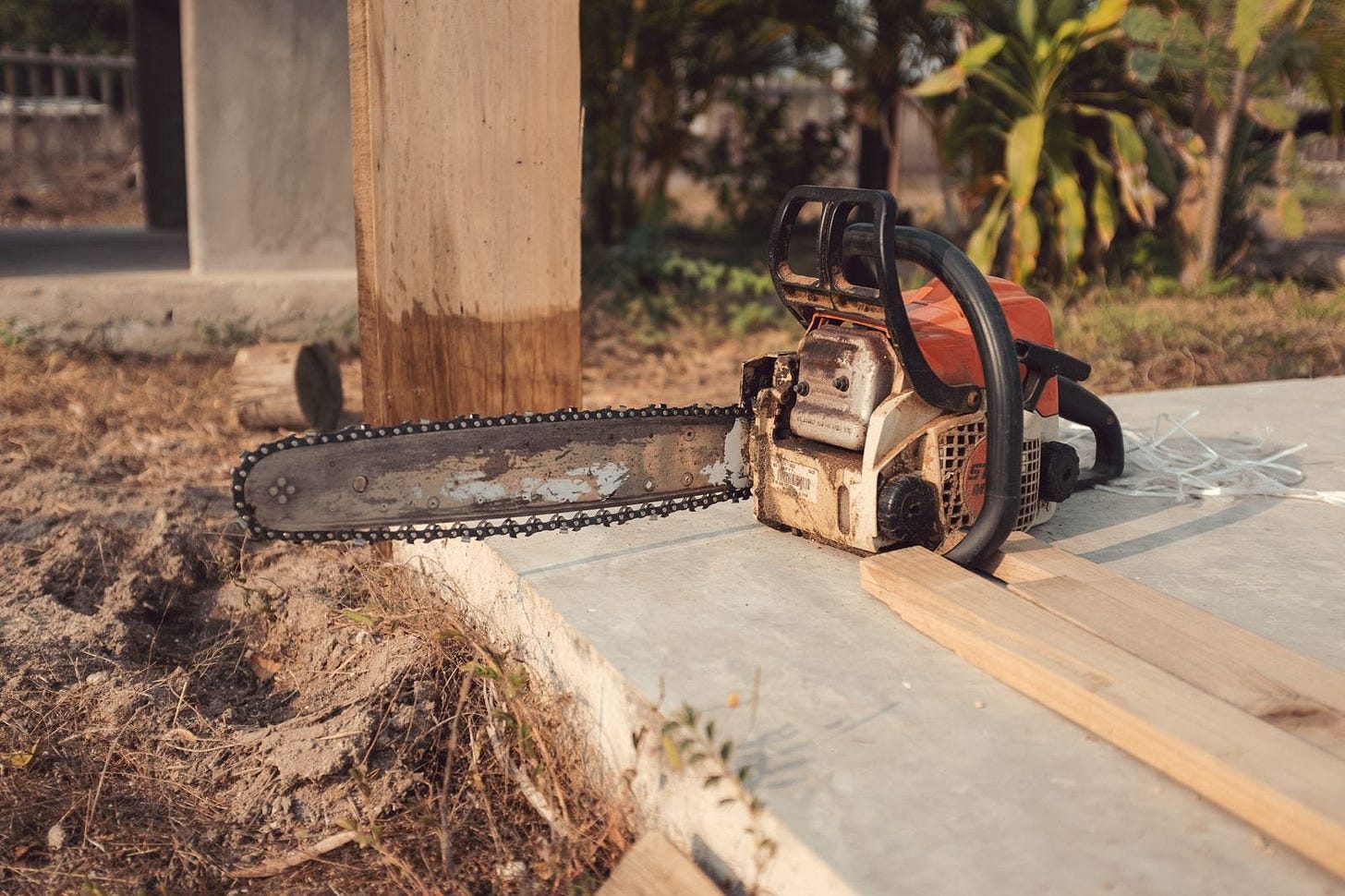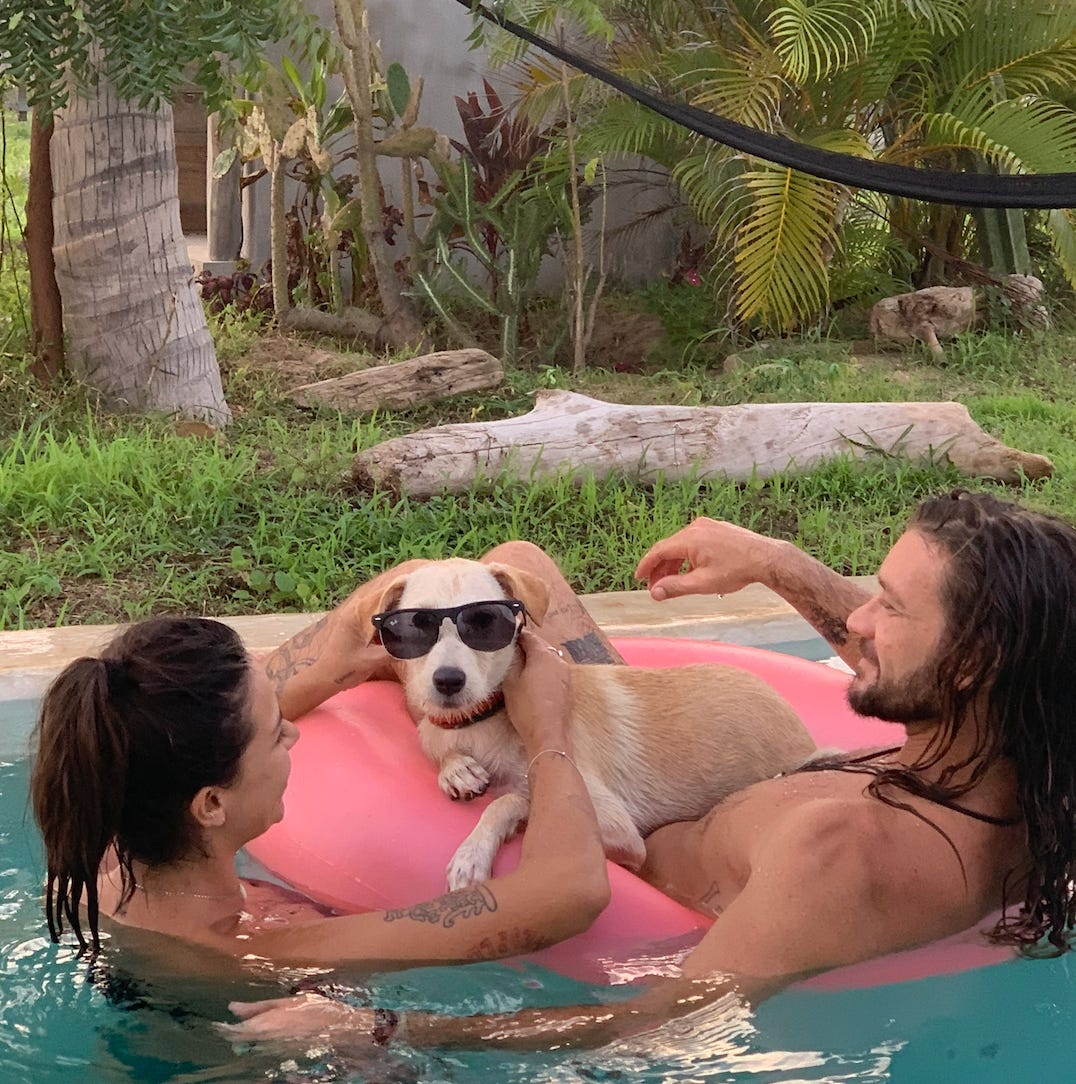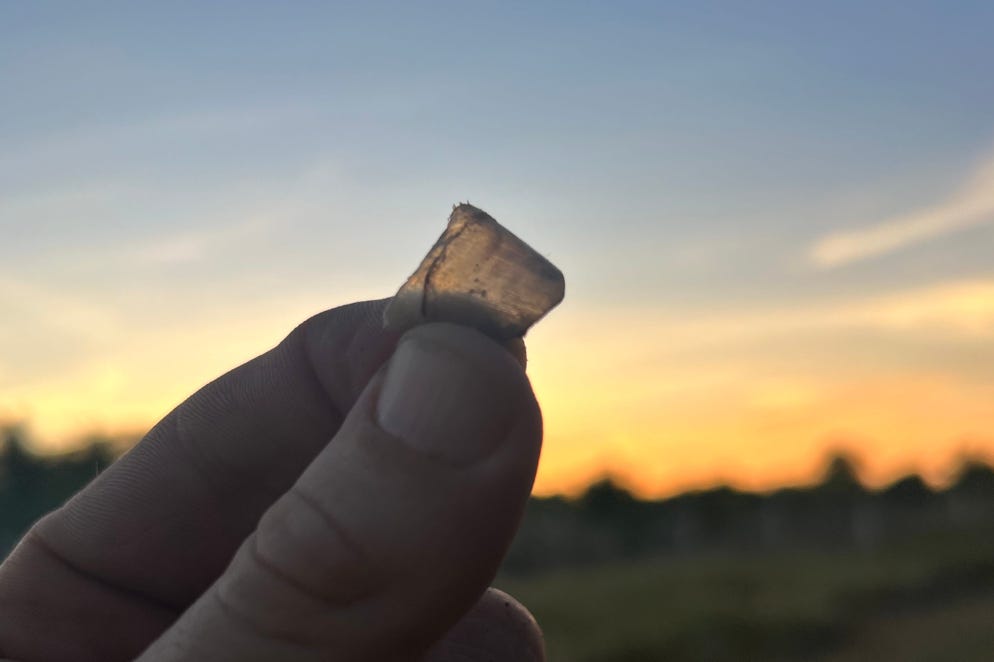How to Start a Commune
Lessons learned from starting a communal project with 15 friends on a patch of paradise in a small Oaxacan beach town
Note: This was originally published in two parts on Medium. It’s been combined here for my audience on substack, and I’ve also disclosed more of the actual financial numbers in the Insider Info section at the bottom for my handful of paid subscribers. Thanks for making the hours of writing feel worth it.
Backstory
Before the pandemic, I used to work at Remote Year, one of the world’s largest travel companies for digital nomads. All 120 of us got fired in March 2020 (can you guess why?), sending us each in a new direction.
We were an incredibly close-knit staff with countless shared adventures and inside jokes—one of which was, “We should buy a piece of land and start a commune somewhere!”
That years-long conversation was half joke, half dream.
My partner and I at the time, Maria (who also got fired from Remote Year), decided to move to Puerto Escondido at the end of 2020, so we piled our stuff and our little 3-month-old rescue pup, Rue, into an old white Ford F-150 that I bought off Facebook marketplace.
For two days, we drove down to the coast and then east to Puerto Escondido, with Rue’s little head poking out the window and smoke occasionally billowing from the hood.
We wanted to buy some land and build a home base in Puerto for the global digital nomad community we were a part of during Remote Year. With my savings and Maria being from Mexico, together we had the necessary pieces to get started. While looking for land for our Coliving project (what has become Sobreluna), our real estate contact, Crispin, took us down the coast one day to show us something that he thought we’d be interested in.
He knew we wanted to build Sobreluna near La Punta, but he was confident he’d pique our curiosity in this small fishing town 30 minutes down the coast. He was right.
After showing us five lots around El Puertecito, a town of around 100 permanent residents, thousands of birds, and multiple gorgeous beaches, he told us, “I have one more lot to show you, which I saved for last.”
That property, a stone’s throw from the town’s center (a basketball court), was apparently “on sale.” The owner owed some workers back pay and was wary of a revolt, so the price was extraordinarily good.
It felt too good to pass up.
We sent some messages to our closest friends from Remote Year, and a few other close friends who we knew might be interested. Within two weeks, the “we should start a commune” conversation was no longer just a joke. We had a team of committed partners.
We divided the 2000 square meters into 10 lots (including two doubles) and carved out a big rectangle in the middle as a common space. Everyone sent their portion of the money, including a bit extra to begin installing the infrastructure (power and water lines), to put up exterior fencing, and to start construction on the first parts of the common space.
We had a “lot draft” to decide who owned which little rectangle, and the two lawyers on the team made two-paragraph contracts, which were signed by each member and Maria (the owner of the full 2000 meters according to Mexico).
That all happened right at the end of 2020. Here we are halfway through 2025, and I’ve learned so much over these last 4+ years.
Four mistakes, or four things I would do differently, the second time around
1. Keep the goats out
So, that goat-based advice is specific to our project. But, the overall advice is that you won’t know all the obstacles you’ll face until they present themselves. Accept that you’ll encounter issues you never could have dreamed of, and then it won’t sting as much when it inevitably happens.
Let’s go back…
The project’s very first rainy season in 2021, one of my closest friends and a partner in the commune, Jason, came down from Mexico City to help me spend $1,000 of group money on plants. The majority of that went to two massive mature palm trees (see above) that we stuck in the ground with the help of an excavator (story for another time), but we spent around $400 on a variety of other plants, concentrated to a few areas in the common space where we wanted lush gardens with flowering plants, cacti, agave, and fruit trees.
Most of the plants seemed happy in the wet soil from the jump. However, after several weeks, whenever I would visit, I would find a few plants destroyed. I couldn’t make sense of it.

One day, when I pulled up to the property in my old truck, I found around 30 goats mulling around the place, many of whom were lazily eating plants that we had bought and stuck in the ground. I realized at that moment who our garden’s enemy was.
I bought rolls of chicken wire, and the next time a fellow owner was there to join me (shoutout Will and Jason), we spent our day stapling chicken wire to the original wooden fence, which had goat-sized slots.
Did you know a goat is like an octopus, and can squeeze through impossibly narrow gaps?
Depending on where you start a group project like this (which is likely be somewhere remote, because those properties are generally more affordable), you’ll certainly have your version of hungry-ass-goats.
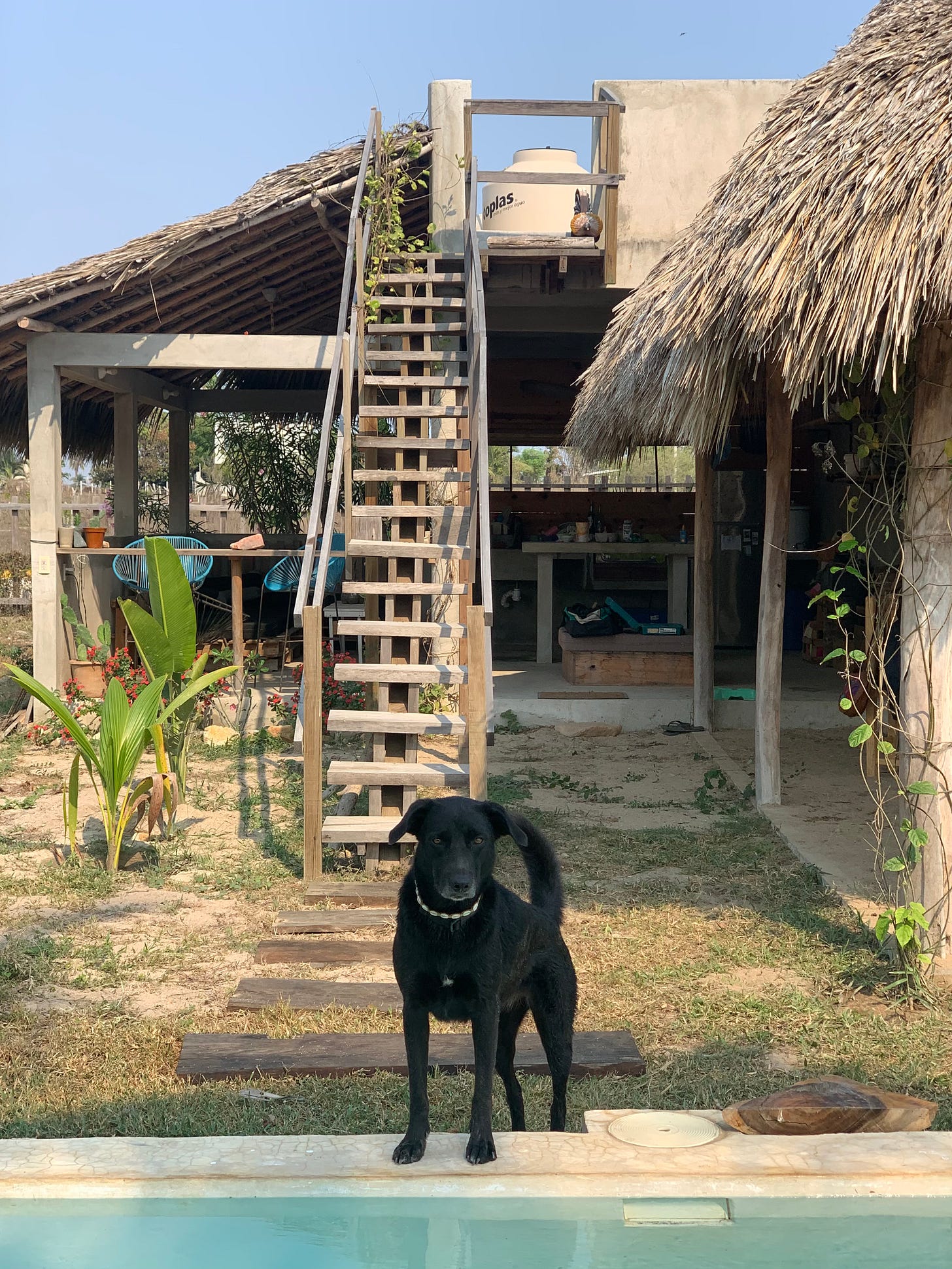
You’ll have to manage something you never could have anticipated and do some emergency problem-solving.
E.g. chasing goats while screaming and flailing your arms.
Our place is now goat free, and our gardens and trees are thriving. That’s also in large part due to (check out this segue… ) our gardener and pool guy, Carlos.
2. Get good help from the start
El Puertecito is 30 minutes away from Puerto Escondido, where Maria and I both live. All the other project partners are spread out around the world, from the Azores to El Salvador to South Africa to Berlin to Portland to Mexico City.
If the property existed somewhere else, we might have been able to get away with visiting every two or three weeks to clean things up and take care of the space, but in Oaxaca, that’s just not possible. In the hottest, driest months, if you don’t water your plants, they’ll die in a week. If you don’t show up, animals will occupy.
If left alone, bats, birds, scorpions, lizards, hornets, snakes, possums, and GOATS will invite themselves into your space to make nests, use the bathroom, and eat whatever they can. Part of what we fell in love with about El Puertecito was the unbridled nature, but that reality comes with harsh challenges (i.e. cleaning up SO MUCH animal shit).
After planting our first big gardens, once we had some of the common space built out, we knew we needed help maintaining the place.
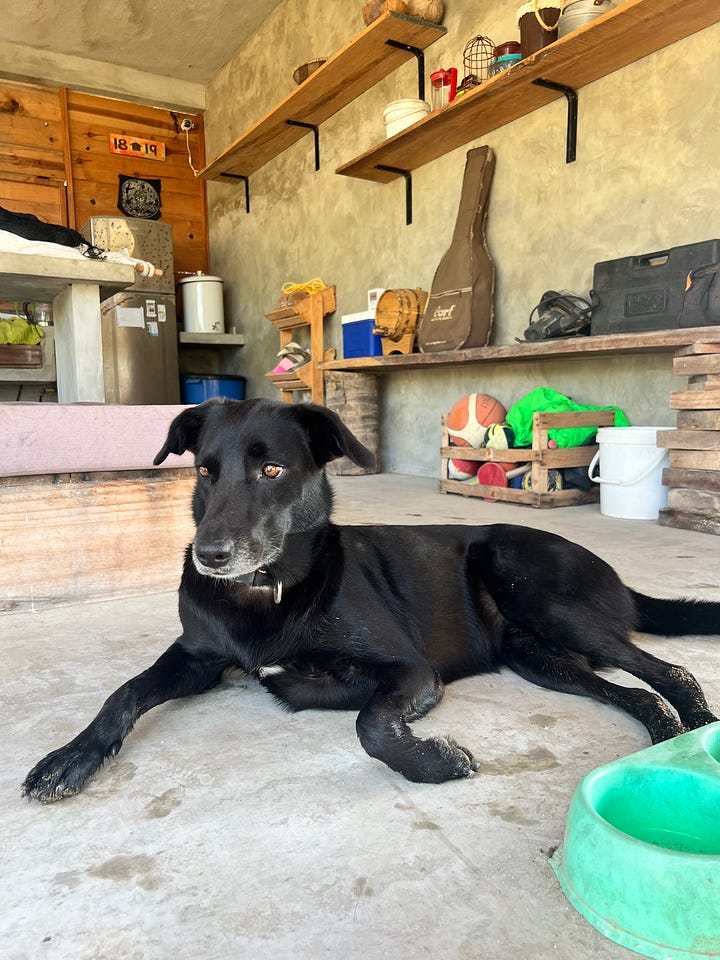
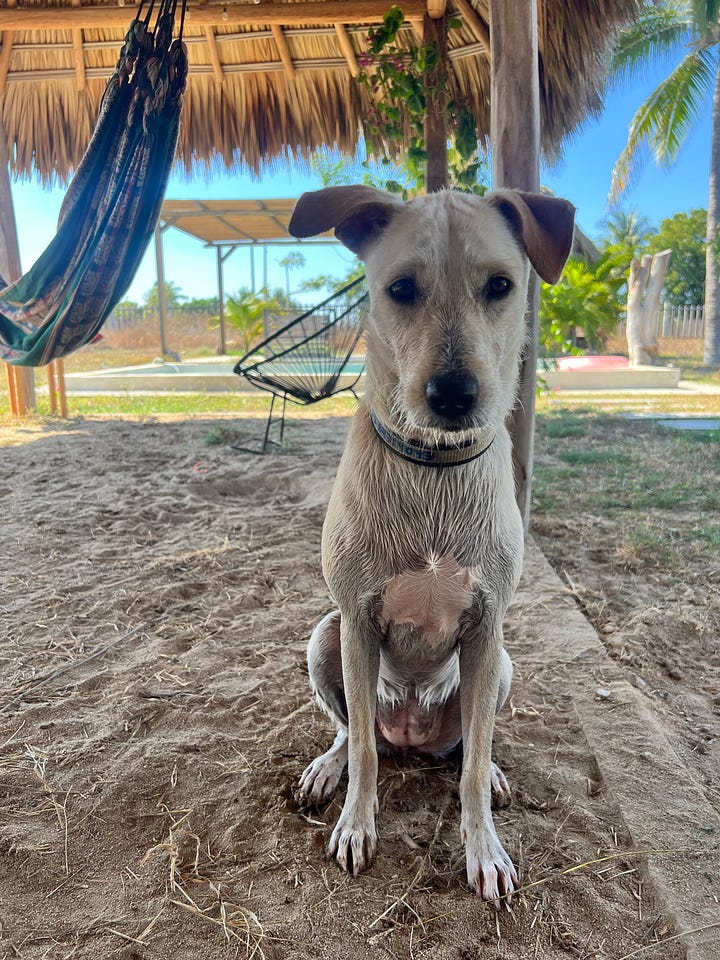
That’s when we hired our first gardner, Maria.
Maria had a husband and 4 barefoot kids who lived around the corner from us. They slept in hammocks above a dirt floor in a house that looked like it wouldn’t survive a heavy storm.
Someone passed us her contact and said, “She could use the work.” It felt like the perfect match. She lived close by, was eager to earn some extra money, and we had a local taking care of our plants and looking after our plot while we were away.
However, after a few months, I grew skeptical of how much Maria was actually helping us. I was still visiting every few weeks to enjoy our slice of nature and to work on the next project, but I would notice an unhappy plant. I would notice a bizarre amount of garbage on the ground. I would notice something broken.
After over a year of concern, we put in security cameras.
Not long after, we saw a video of Maria dragging a small coffee table out of the shot. I built that table myself from repurposed wood and then painted it white. I really liked that table.
When I visited next, I found the table broken and surrounded by over 50 beer bottle caps jammed in the sand. I was done.
I called my Maria and told her that we needed to fire our gardener, Maria. That she’s doing more harm than good. That we’re paying her money to break our shit and kill our plants.
My Maria was rightfully nervous about firing gardener Maria for various good reasons, but she could tell from the emotion in my voice that I was at a breaking point, and eventually agreed it was time to move on. I hung up the phone, a bit shaky and fighting back tears. The emotion didn’t rise because of a table, but because the truth finally sank in.
For over a year, we were being constantly fucked with by someone who we were paying to help us.
Luckily, we had just finished a major milestone in the project — we finally had a pool! As with any pool, you need a pool guy, so we hired a man named Carlos, who came strongly recommended and lived in the area.
He made a great impression during his first few months of cleaning the pool and managing the chemicals, so after having that emotional conversation with Maria, we asked him if he was interested in also being our gardener.
That one change, moving from problematic Maria to helpful Carlos, has changed the way I feel about our shared project more than any other decision. Having actual help on the ground makes an enormous difference when trying to maintain a property.
For the first two years, I often felt like I was fighting a losing battle. Things were always one step forward, two steps back. But since Carlos came on board, the project has felt more like one step back (we’re still in Oaxaca, and it will fuck you up), two steps forward… and things are steadily improving over time.
Today, our place is more beautiful and put together than at any point in its history, in large part thanks to the consistent help of Carlos.
I now have the energy to advance on new things, instead of spending my energy replacing dead plants and fixing broken tables that the drunken gardener danced on.
3. Wait until you’re almost certain you need something before you buy it
While designing the common space as a group, we decided to put a big glamping tent on a 5 x 5-meter platform toward the back of the space. We ordered the $1,000 tent from a well-rated Belgian company (in part because it was advertised as all-weather). It looked great in photos and was slept in about five times before enduring its first rainy season.
That season brought a severe tropical storm, which toppled the tent, ultimately ruining it forever. (The canvas ripped in the storm, mold took over the inside, and even after a full day of power washing with lime and vinegar, the mold won.)
Our assumption with the tent was that we’d need a decent place to sleep, especially if someone came out to start building their own little cabaña. We haven’t replaced the tent, and I still stay out there all the time.
If I’m being really honest, I think I always preferred sleeping in our indoor/outdoor lounge on the pallet couch cushions, even when we had the tent. I just used the tent that first year because we had just spent all that money on it.
Luckily, with a group project, a disaster like losing the tent or the pool pump breaking means everyone is out $100. The financial pain is basically 10 times less, but still—It feels very silly to think that every night spent in the tent cost around $200.
The other example that’s painful for me to write about is our kitchen stove. I’ve cooked around 50 times out at our property, but I always cook in our beautiful fire pit. I love cooking on an open fire.
From the start, we included a four-top stove in the plans and even carved out a specific section on the concrete kitchen countertop for the stove.
However, it’s now almost entirely rust-covered and has yet to be used.
Purchasing that $200 stove and letting it slowly rust for 3 years is about as close to burning $200 as you can get.
In our collective minds, when we imagined using the space to its full potential, we pictured ten of us there, catching fish in the ocean, and preparing those fish, along with other sides and fresh salads, to be set out in a family-style dinner under our little palapa.
When you imagine creating that scene, it feels as though you’d need a little stove. We assumed it would be well-used. It turns out, we only cook on the fire, and the stove was bought to simply sit and rust in the salty air. We’ve had many family-style dinners out there now, but one source of fire to cook on is plenty — and for me, it’s not even close which option I prefer.
I MAKE FIREEE!
Basically, building out a place like this can at times be like buying clothes. Sometimes you pick out a shirt off the rack, but for some reason, you never end up wearing it. Other times, a free thing you found or got from an event becomes a well-worn keepsake that benefits your wardrobe.
It’s hard to know what certain things are going to provide in time, but you’ll never know if you don’t get them. Sometimes, things bought with excitement fade to the back of the closet. Sometimes, a found piece of wood becomes one of your favorite decorations. I wear a hat I found on the highway far more than an expensive one my sister got me for Christmas.
It’s impossible to predict.
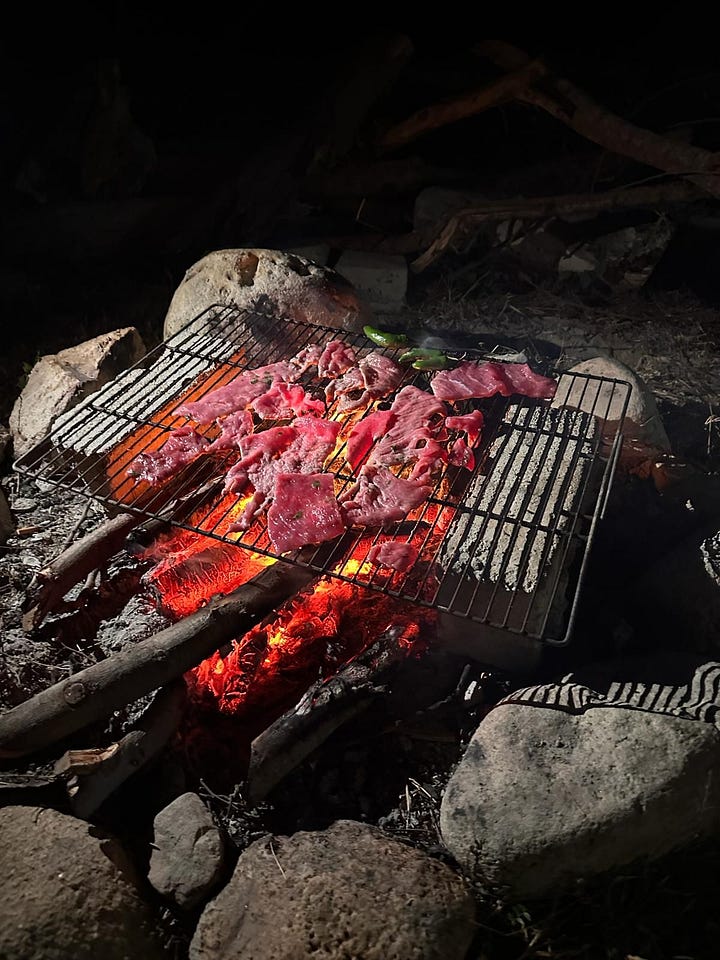

Looking back, I wish I had waited to have a few dinner parties that made me think, I really wish we had a stove, before we bought one. I wish I had stayed out on the property without the glamping tent, to see if I had the thought, Man, a really nice tent would make staying out here so much better!
If you have those thoughts based on experience, you can be far more certain that what you’re buying is a good use of money. If you just get something hoping it becomes well-used or essential, you’re rolling the dice.
Sometimes it will work out, but sometimes you’ll end up with a rusty stove you can hardly look at, just like an expensive shirt jammed in the back of a closet.

4. Avoid burnout, and be realistic about everyone’s active involvement.
There’s some version of a shared project like this one, an intentional community, that likely involves a “chore wheel” or very clear delineation of regular responsibilities. A project where everyone lives close and all members are expected to put in equal amounts of sweat equity.
That is not our project.
During the years of our drunk gardener, my stress was growing, and so was Maria's. I could feel myself getting burned out. I was forcing myself to go visit the property on weekends, knowing that I would find something incredibly frustrating when I arrived.
Knowing I would be there alone to fix it. Knowing the best I could hope for was a “good job, Trav” message in the group chat, followed by a couple of heart emojis, to acknowledge I spent my entire Saturday working on this project, working for the group.
That pat on the back was enough to keep me going for almost two years, but it wasn’t sustainable. Maria was over the stress as well.

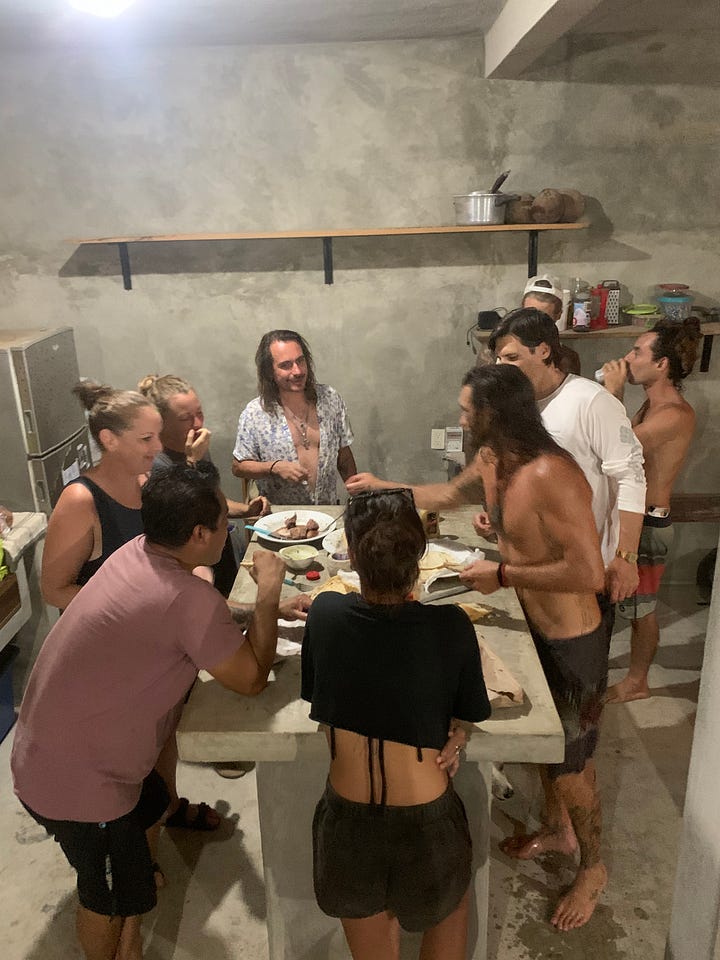
Note: From the beginning, Maria and I included a “project management fee” to compensate ourselves a bit, as we knew getting this started was going to take a ton of time and work. We included that in the very first pile of money we gathered to buy the land and start construction. That money certainly helped to stave off burnout early on, but it felt long gone by the time we had the fence up.
I’m including this detail for historical accuracy, and because it was a good idea — but we should have known it wouldn’t cover an infinite amount of work for an infinite amount of time. It covered about two years of work in the end, before the burnout started to weigh heavy on us both.
At some point, Maria and I talked and decided that we needed to tell the group that we were getting burnt out. That it was in part because almost nobody was ever coming down to spend time or help us on the ground, as we all originally imagined.
We thought the original project management fee was long gone, and that our efforts on site were at least worth minimum wage. How that bit of money would help stave off the growing burnout, which would protect the project's long-term value. That we would track our hours and pay ourselves $15 an hour for time spent keeping our project beautiful (Read: Lots of sweeping, fixing things, and cleaning animal poop).
At this time, Maria also told me she was happy to continue to be the point of contact with the delegation and local community, but that she didn’t want the pressure of checking in on the place and doing physical work a few times a month.
We agreed on an 80–20 split of the overall work the project required, and that her 20% would be focused on communication, the backend, and keeping us organized, and mine would be … cleaning animal shit! I kid, but yeah—my 80% was all the sweaty parts.
We told the group that this might slightly increase our yearly dues, but that it was necessary to avoid burnout and to keep us committed to maintaining the project. We were candid that burnout was creeping up, that those few nice messages and subsequent emojis weren't enough anymore.
We told them…
We’re happy to be here doing the work, all we ask is that you’re okay with us earning a bit for our time and effort, and we’ll include that in the yearly dues. If you guys send your dues with a smile, and we aren’t out there sweating under the Oaxacan sun for free every other Saturday, that will help very much with the burnout!
Luckily, we started this project with the best possible people (more on this coming), and they were more than fine with this arrangement. Overall, the partners were really thankful, and several even said nice things about not realizing the toll that all the stress and sweaty afternoons had been taking.
“Labor of love” is a great concept, but I don’t think it’s ever sustainable long-term.
This conversation happened right around the time that the pool was finished and gardener Maria was fired, just over two years ago. That window of time in the project's history changed everything for me.
One month, I was burned out, incredibly annoyed with our gardener, and stressed that the big pool project was going to turn out well (more on the pool coming up).

A few months later, we had a beautiful pool, a hard-working, responsible employee (we even gave him a Christmas bonus this year, that’s how much we like our gardener), and I was making $15 for every hour of hard work I did to keep things growing in a positive direction.
The changes that occurred in that window of time are a huge reason why I love the project again. Sure, sometimes it’s still stressful (the goats actually got back in a few weeks ago, there was a possum in the bathroom recently, hurricane Erick, etc.), but today, I have far more feelings of joy and love than I do stress and frustration about El Campo 167.
At the end of 2022, the opposite was true. I had to force myself to go there. Now I make the drive with two beautiful dogs and a huge smile.
I hope this article helps to get you to that place in less amount of time than it took me.
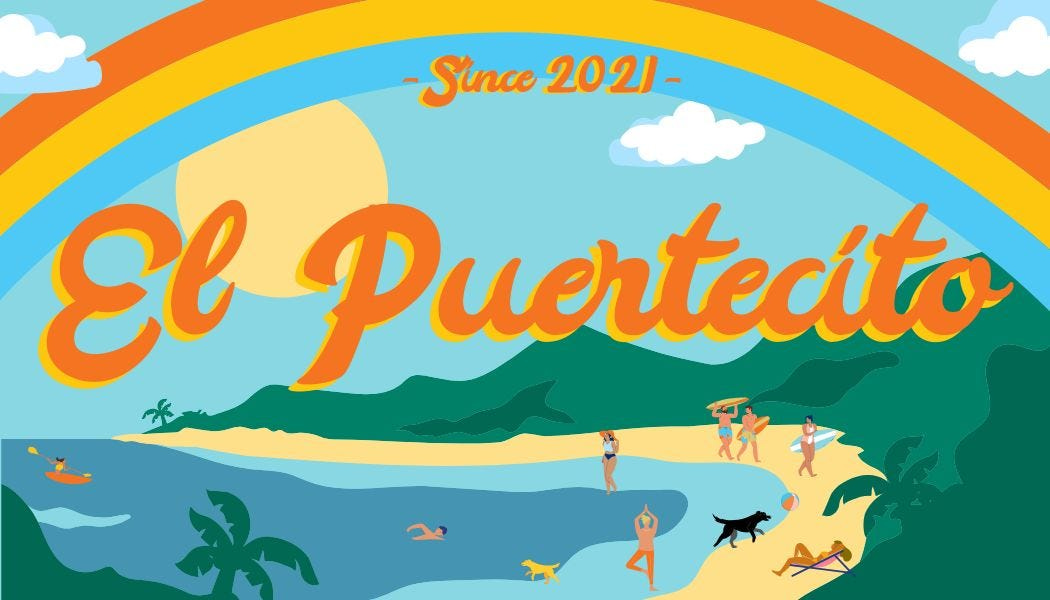
Let’s bring you up to the current day
As described in the backstory, we got incredibly lucky with this property. It was the type of thing where I knew from day one that the “worst case scenario” of trying to pull this off is to sell for a profit down the road.
People could always sell individually, or maybe we would decide as a group to sell if things got too difficult. Either way, the assumption was that we would only ever lose time and energy, not money.
Right now, we’re going through the process of 4 of the original partners selling their lots because life has taken them further from Mexico, or because they have new projects, houses, or businesses that need funding.
We’re in the middle of our first major transitional period as a community. It’s a bit sad and a bit exciting.
This transitional period is what triggered me to write about my experience with El Campo 167. It’s caused me to reflect a lot on what I’ve learned, what I would do differently, and here in the second half—what I would do again.
Four wins, or four things I would do again, the second time around
1. Jump at prime opportunities, trust your intuition, and then make a stupid slide deck
Knowing from the jump that we made the best possible land purchase imaginable made the pain of some of the early struggles and stresses (i.e., drunk gardeners) easier to swallow.
It made it easier to forge ahead, to push the project into a place where pride sat heavier on the scale than frustration.
From the beginning, our assumption about the worst-case scenario was that each lot owner would send around $500-600 in annual dues, potentially never visit or even think about the project, and the value of their lot would go up more than $600 that same year.
You can check out, and basically know that you’re investment is going up in value.
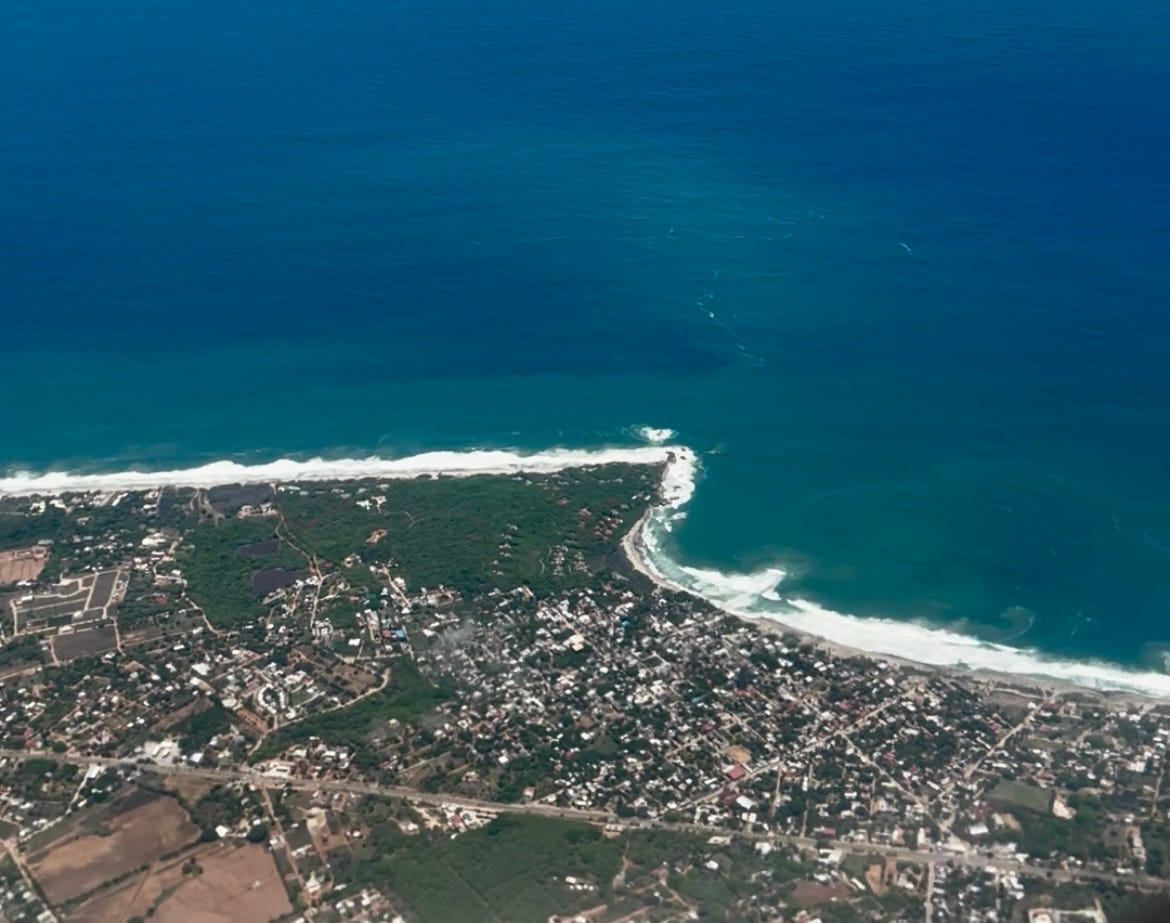
That assumption has turned out to be correct, as the four folks selling this year are all leaving with around a 20% profit on their overall investment (i.e., 5 years' worth of dues, plus their original investment, and then add 20%… that’s what they’re getting back.)
Actual rough numbers shared below in the Insider info section for my few paid subscribers.
This is only possible because the land was purchased at an incredible price, and because it’s right in the middle of the Oaxacan coast between Puerto Escondido and Mazunte, which is a stretch that we knew would increase in value.
With the new highway, bigger airport, and rapid growth around Puerto Escondido, the value has gone up even more than we optimistically guessed that it would.
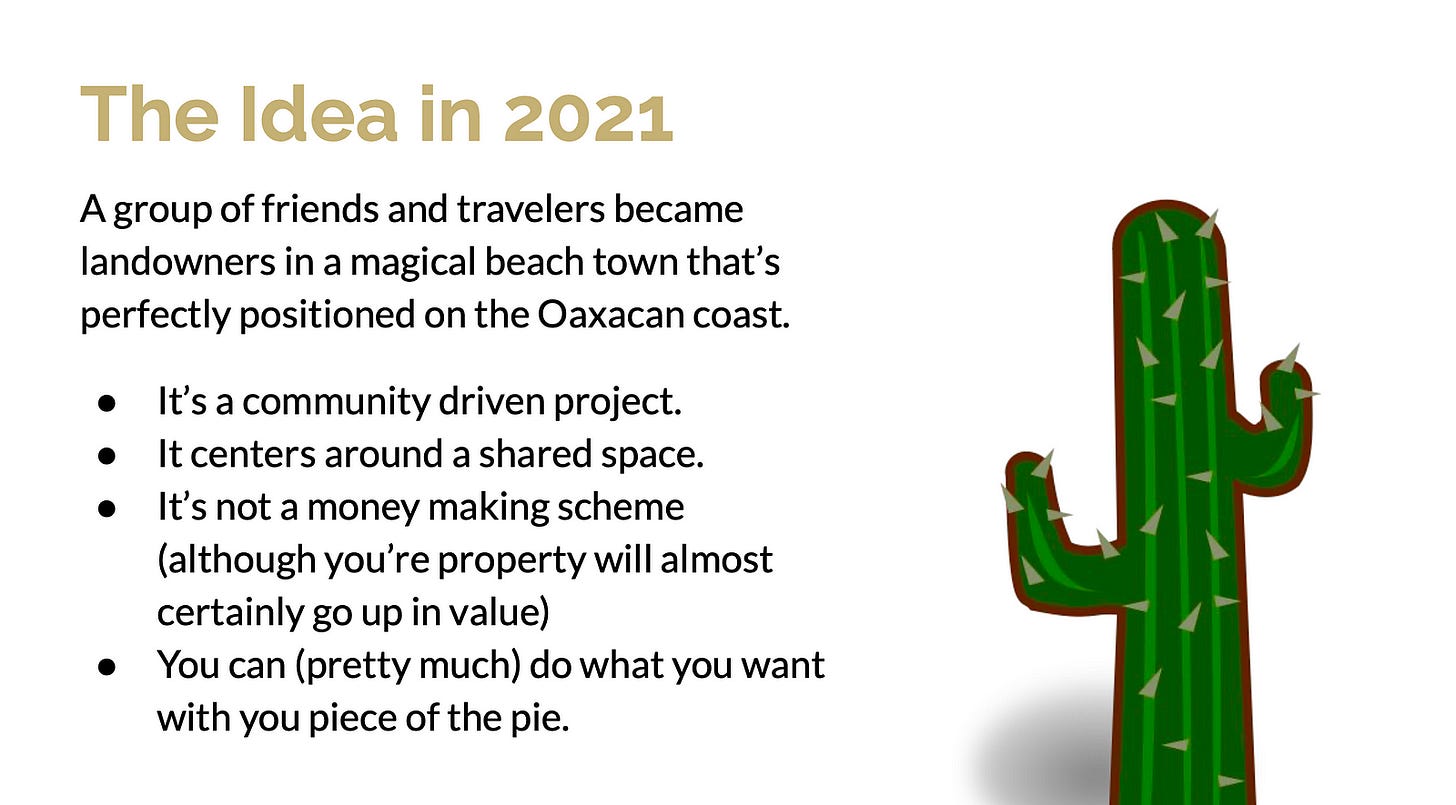
I could say “we got lucky,” but Maria and I knew from the start what we had with this piece of land. We were able to communicate that idea to some of our closest friends, using a very goofy slide deck we made with a lot of love. Once we had that group together and this incredible deal on a gorgeous piece of land, we were set up for success.
The land is a huge part of that, but also the people—the people make the project.
2. Do it with people you love and trust
The five years that I worked as the Director of Community for Remote Year will always be one of the best chapters of my life. I was getting paid to travel and build community — two things I love deeply. On top of being a dream job, Remote Year was a dream team.
I was fortunate to be hired in 2015 as one of the first 10 employees, and I met some of the best people in the world during that next stretch of my life. The company disbanded during the pandemic, was acquired and briefly revived by Selina, but after Selina went bankrupt, Remote Year was bought again and ultimately scrapped for parts. It no longer exists. #quetriste
However, that early pre-pandemic team that built the company is still super close. We live all over the map, but see each other as often as possible. Our WhatsApp chat is lit (fire emoji).
Recently, a lot of us were together at Zeke and Alinee’s wedding outside of Oaxaca City. Zeke was also an early Remote Year hire and is one of the founding partners of El Campo 167.
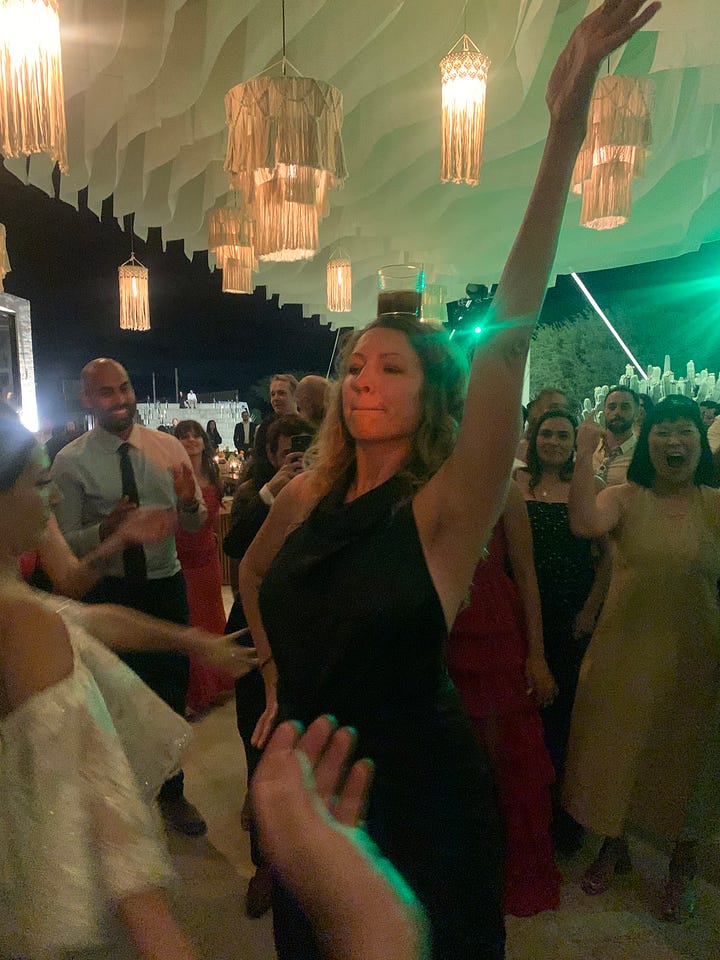

Having a group of friends that you can count on, that you love, that you want to work hard for, is one of the most important things to get right if you want to pursue a project like this with a million unknowns.
The one thing you can be certain of is that there will be challenges, and navigating challenges with a team of people you love and respect ensures that the outcome will be fine, no matter what happens.
Often, the outcome is amazing, like when my brother brought an insane toilet seat to Oaxaca from the US because I mentioned once that I wanted a cheesy one with shells and nautical trinkets melted inside of it like you’d find at an old lady’s beach house.

While working at Remote Year, Trish was my boss (shown above, with a drink on her head). During Remote Year, she was VP of Experience and the boss of several of the folks who eventually started El Campo 167. The “let's start a commune” joke originated with her, so of course, she’s a founding member.
As someone who reported to Trish, I distinctly remember this feeling of not wanting to let her down. It wasn’t because I was scared to let her down; rather, it was because I really wanted to make her proud. She was an incredible boss.
That’s the exact same feeling I have now, working on behalf of our entire community. I want to make my friends proud, and I’m glad I make $15 an hour for the effort, but it’s not the reason I spend my Saturday afternoon fixing the well cover or cleaning the bodega.
It’s because I love these people and I want to do right by them.

3. Someone will likely need to be the point of the spear, so know who that person is and make sure they’re up to the task
After finding the land, after calling and messaging some of our favorite people to buy into this vision, after making the goofy slide deck, after sharing the bank info and collecting enough money, after paying and signing the act of possession, we were so excited.
I was so excited that I remember thinking that some of the community members might relocate closer to the place.
No one said that, I’m just an optimist by nature.
I was certain everyone would visit a few times a year. I was also sure we would have at least one annual meet-up where the majority of the partners would come to spend time together at the place… that would be the time when we would catch fish and cook on the stove.
That would be where the inside jokes, traditions, and collective history of the space came from. That would be the weekend when a hilarious conversation around the campfire would lead to a brilliant name for the project.
None of those things happened.




I made an effort for 3 straight years to manufacture a “high season” for our patch of paradise. I sent out a Google form to try and see what month people had the most availability.
I wasn’t able to manifest it.
We’ve certainly had people visit, especially Jason (see above, holding a coconut we got from one of our very own palm trees… what a feeling!), who comes down from Mexico City a few times a year.
I don’t want it to sound like I’ve been alone at it for the entire 5 years, but I’ve certainly been way more alone with the project (and my dogs) than I originally imagined.
After Zeke’s wedding, we had a really fun crew of 7 people stay the night out in El Puertecito.
We caught a lobster with a spear gun, opened it with a machete, and cooked it on the open fire. We made some great inside jokes that night. Jokes you wouldn’t get because you weren’t there.
The lobster’s name was Alfredito. He was delicious.
I just imagined some version of that lobster scene would happen a few times a year, but… no.
I’ve come to terms with the reality and rhythms of El Campo 167, and I’ll relish those special gatherings whenever they do happen.
Ultimately, even the name itself wasn’t born from some hilarious inside joke; it was born of necessity. It wasn’t fun to call it “the project” or “El Puertecito,” so after a few years, we took the mile marker and slapped El Campo in front of it. El Campo 167… it sounds official. It’s at least something to paint on a sign.
More than anything, I’ve had to come to peace with being the point of the spear, and the reality that being the point of any spear can be a bit lonely at times. The majority of trips I make to El Campo 167, I’m alone with Rue and Torta.
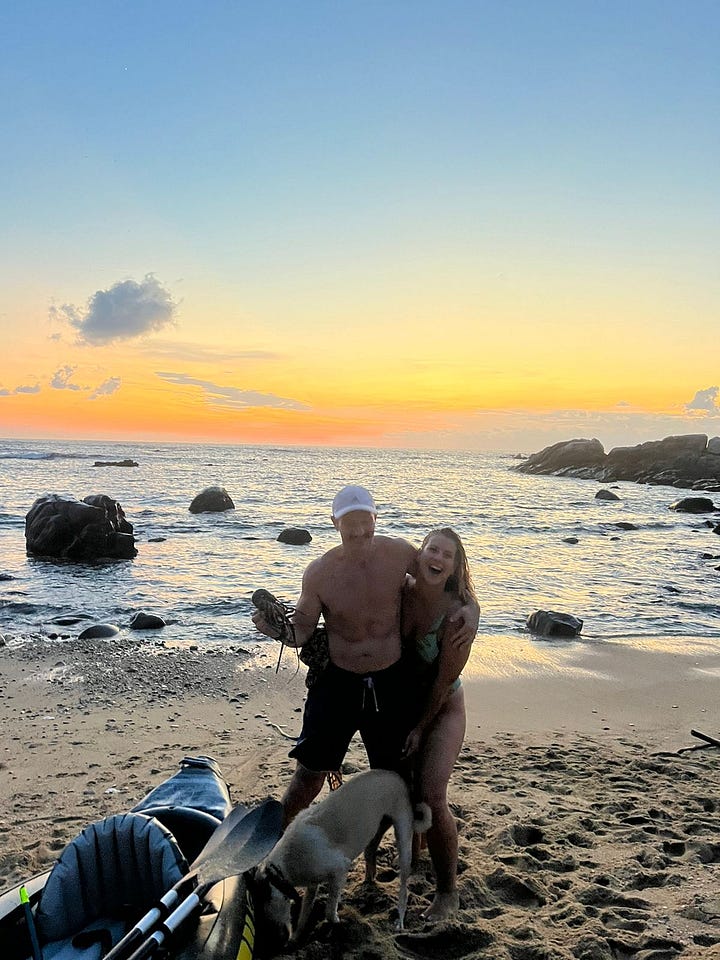
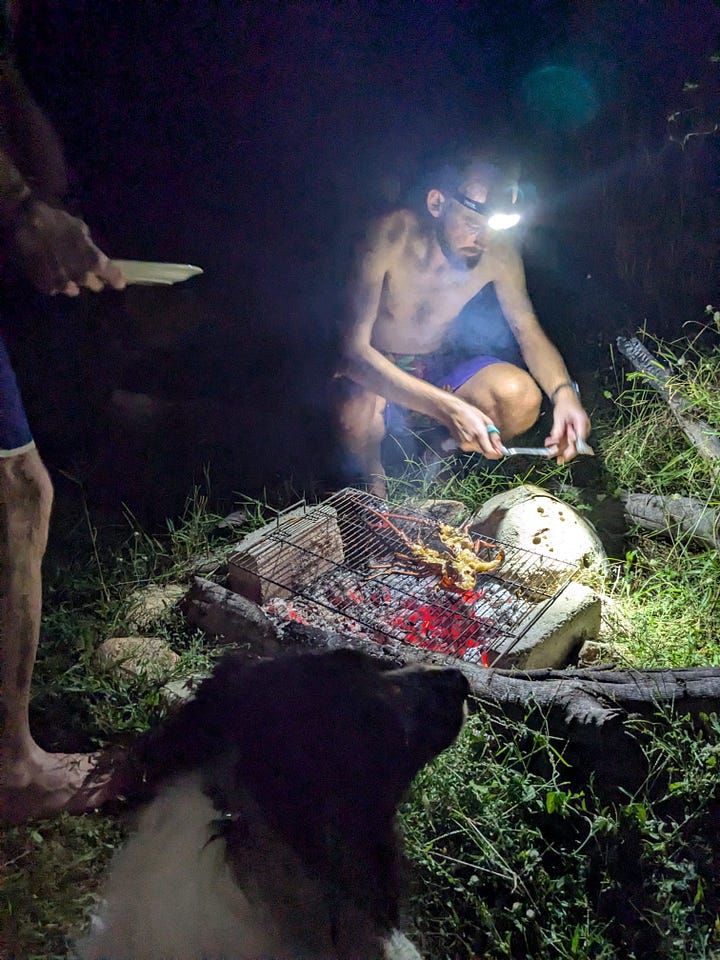
I enjoy the solitude and nature. I enjoy working hard for this group of people I love. I really do appreciate the “Good job, Trav” messages. It just took me around 2 years to accept what a less optimistic person might have known from day 1…
A project like this needs to have someone to lead the charge—that job is often lonely, and that job is yours! You’re the one who called your friends and made the slide deck after all…
The phrase “point of the spear” got stuck in my head after a conversation I had with my mate, Nico, one night. Nico started New Ruins, an amazing project about an hour west of Puerto Escondido.
He said, “Someone needs to be the point of the spear,” as we were commiserating about our various challenges. It helped me to just accept the responsibility and to be grateful that I had people helping to hold the spear.
I really like the visual nature of the expression. As I push hard to continually improve things, I want to look back and feel 11 other sets of sturdy hands also pushing forward.

That push can take different forms, like coming down to help with work projects, carrying toilet seats through customs, supporting the project by sending your annual dues on time, or even sending a sincere “Good job!” message when you see sweat being spilled for the cause!
Note: Now that we’re adding four new community members to the project, fresh blood that either lives in Puerto Escondido or spends apart of the year here, I imagine that going forward I’ll have more help on the ground. I likely wouldn’t have dared to start this with a different group of people, but now that some are leaving it feels obvious to invite great humans who are closer to the land to consider joining our little fracionimento (sub-division). If I write an update in a year, I’m guessing things will feel a bit different. Basically, if you’re starting a project like this from the beginning and can have more locally-based members, I think that’s a huge plus.
4. Hands-on and cheaper, or hands-off and more expensive?
As the point of the spear, as well as the holder of the group pot, I feel a deep responsibility to use the group's money wisely.
When our machine room flooded and the pool pump broke, I felt awful having to relay that information to the group (try to make sure your pool’s machine room won’t flood in a heavy storm). When we calculate expenses and then do some basic math before asking the group to send over their yearly dues, I hate that part of my role.
I don’t like asking for money, but it’s a necessary part of a project like this.
Whenever we do ask for money, I always want it to be less than it probably should be, and need Maria’s voice of reason to say “Trav, let’s just call it $600 each, instead of $500, which will likely run out in October… It’s better if the money spills into next year instead of running out two months early.”
I like to do things for the project to keep expenses lower.
I collect and scavenge useful things for the property.
A lot of the furniture I built myself out of repurposed wood.
We found our refrigerator on sale through a Facebook group.
I constructed the pallet couches in the lounge.
I built the compost toilet shed in the back.
I built the well cover.
I built the new machine room cover.
My friend Ryan and I put up an enramada above the cement slab where the glamping tent used to live. (See photo above… thanks again, mate!)
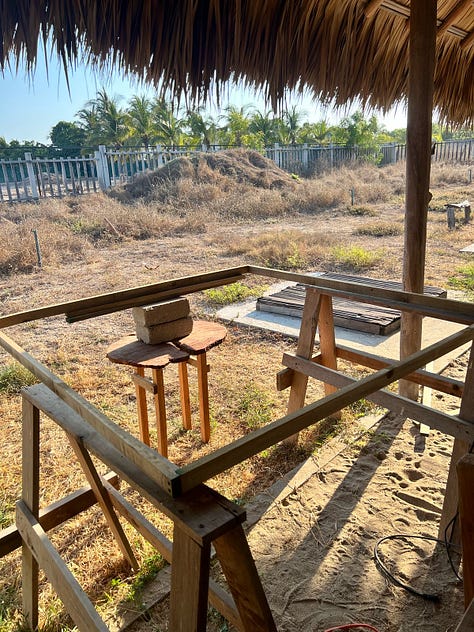
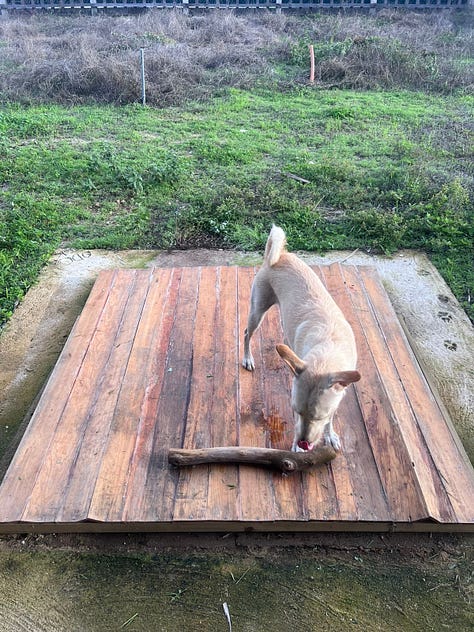
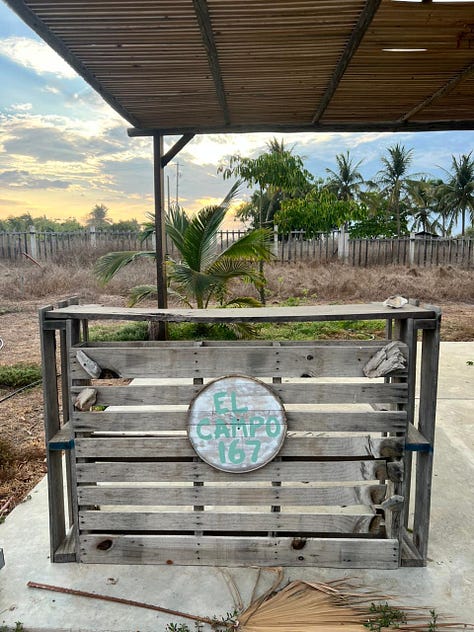

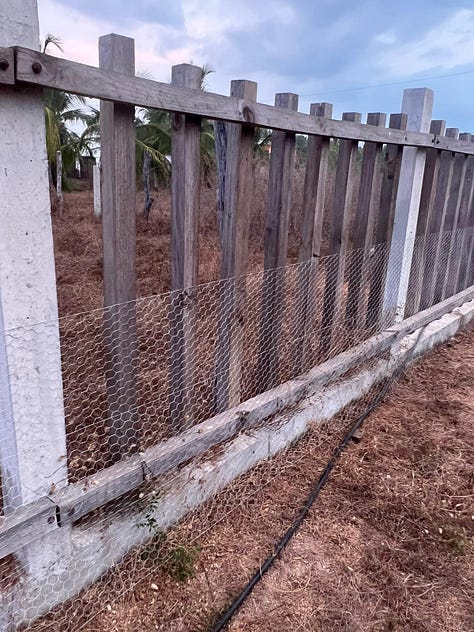
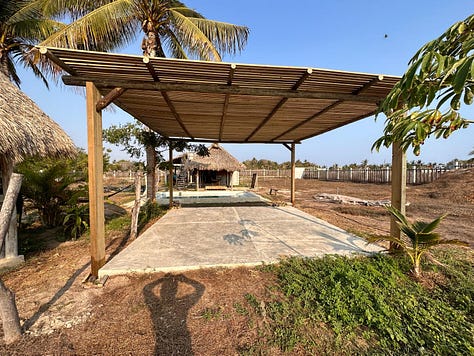
In this project, as with all projects, you’ll have dozens of decisions to make that are essentially “do it the hard way for less, or the easy way for more.”
The first giant example of this for our project was the initial build of the common kitchen, lounge, bodega, and bathroom. We decided to go with a local architect and builder named Rafa, who constructed in a simple yet beautiful way.
He would communicate with a foreman at the job site out in El Puertecito, in hopes that his crew would understand the blueprints and execute them well. He was in charge of the build, but wasn’t always there.
Often, his team did not understand the blueprints.
One day, when I went to visit to make sure the construction was going well, I found a random wall being built that separated the kitchen from the lounge. We wanted an open-floor-plan feeling to the space. We wanted to be able to get off the couch and walk directly to the sink.
I called Rafa and said, “They’re building a wall that shouldn’t be here.” He apologized and corrected the mistake.
One day, I went out and found a 5x5 meter cement slab already poured where I was planning to build a wooden deck. I called Rafa, who apologized and told me that we wouldn’t have to pay for that cement because he knew it was a mistake.
We had discussed this wooden deck and my plans to build it myself many times. On the blueprint it was just a square, and I guess the workers said, “FUCK IT, LETS POUR SOME CEMENT!”
Ultimately, Rafa and his guys did a great job building nice things at a low cost, but I felt like I had to be there to check in on it all constantly during those few months. We could have certainly paid someone more, who we would have had to oversee less. I’m glad we went the cheaper but more involved route.
The same thing happened with our pool. After getting four different quotes, we decided to go with the cheapest. We found one option — working with my friend Osab — that was over $5,000 cheaper than the other quotes we received.
Had we gone with super professional pool builders and just raised more money from the group for that, it would have been easier. I’m glad we went with the more hands-on approach, which resulted in a gorgeous pool, a handful of sweaty afternoons out at the job site helping, and a lot of money saved among the partners.
Being willing to put in time and sweat equity will always lower the overall project costs, but if you’re doing a lot of work alone, it can also lead to burnout. Finding the balance between those two competing factors has taken me the better part of 5 years to figure out, but I think I’ve finally found the right rhythm.
Now, that cement platform where the tent was has a nice shady enramada above it (see photo above), and is a multi-purpose space that can be used for yoga or as a dance floor. It’s a better use of space.
Final Thoughts
Has it been hard? Yes.
Has it been stressful? Yes.
Has my truck broken down in El Puertecito? Yes, several times.
Have I gotten stung by a scorpion? Yes.
Have I had to chase a possum from the bathroom? Yes.
Would I do it all again? FUCK YES.
I’m incredibly proud of our shared project in El Puertecito, and I’m incredibly grateful to this group of founders and dear friends for seeing the potential and for taking our goofy slide deck seriously.
We’ve managed to do something that most close groups of friends talk about after a few mezcals, but never actually act on. I’m glad we’re the type of people who don’t see the world as a bunch of gears and cogs that we have to fit into, but rather, a place where we can dig our hands in like wet clay.
A place where the rules are suggestions. Where we squint suspiciously at the blueprint for adult life that our parents handed us while holding it upside down… no, no, no, I don’t agree with this, we think.
We decided to do something hard, something a bit scary. But I’m so damn glad we did.
Thanks for reading. I hope this helps inspire and inform you if you have a similar dream.
You’re all welcome to the next pool party at El Campo 167.
Because it’s tradition…
One of my favorite traditions in El Puertecito is making everyone answer this simple question…
Is this poster at our local tienda Jennifer Lopez or Angelina Jolie? I’ve polled over 50 people at this point and the answers are very mixed. Please let us know what you think in the comments.
Finally, just for chucks and gigs…
Finding the RY group shot from the wedding proved difficult, but in the process, Zeke sent me these ridiculous photos. I was having the best time, in the weirdest shoes… and then flip-flops (because my shoes exploded on the dance floor)… and then I lost a big toenail.
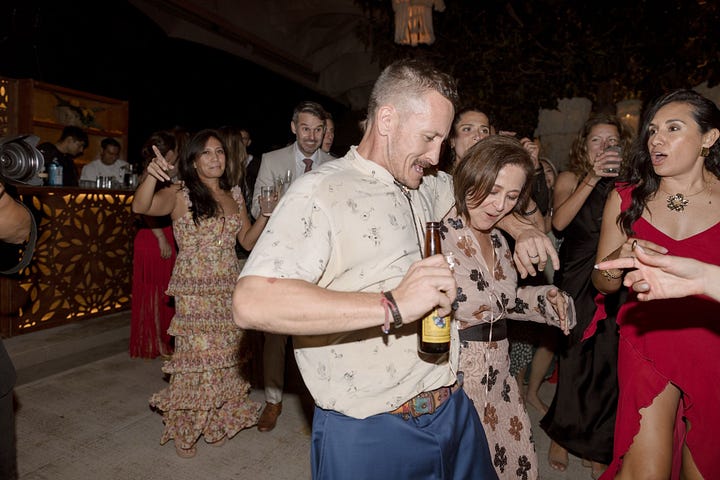

That toenail turned black, and a few weeks later, it fell off while I was working the land one afternoon in El Puertecito.
Wow, what a full-circle way to wrap this up.
Insider Info: Real prices about the project, for the curious or serious.
Keep reading with a 7-day free trial
Subscribe to Sobre Puerto Escondido to keep reading this post and get 7 days of free access to the full post archives.











